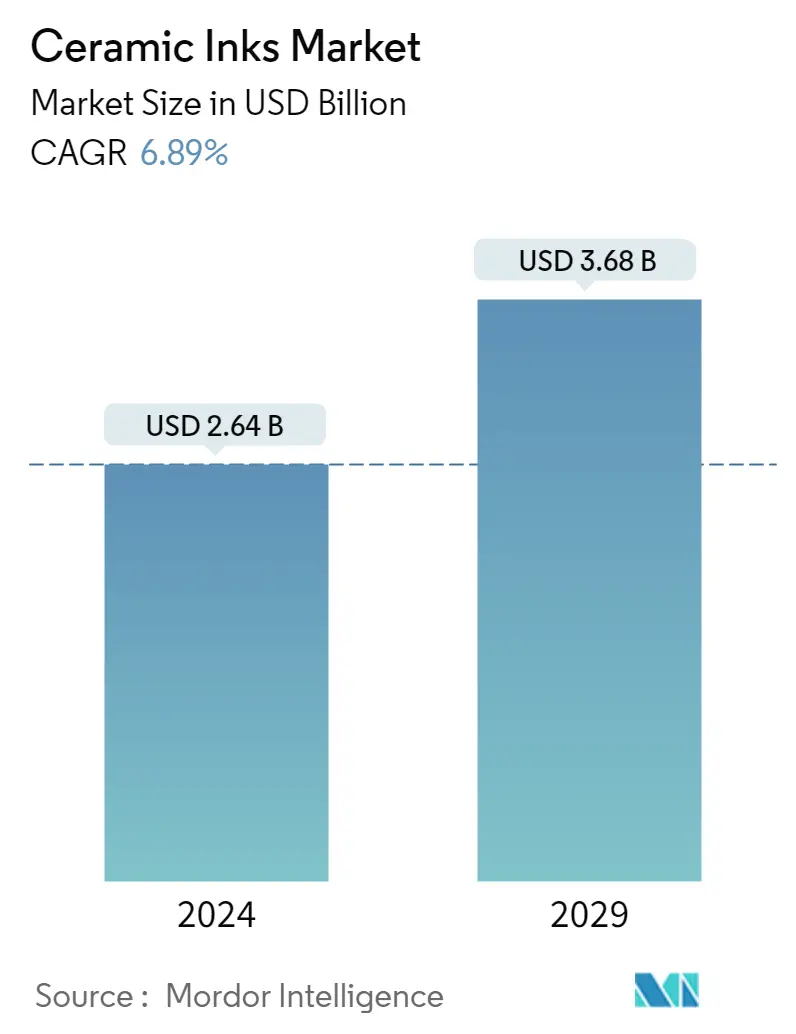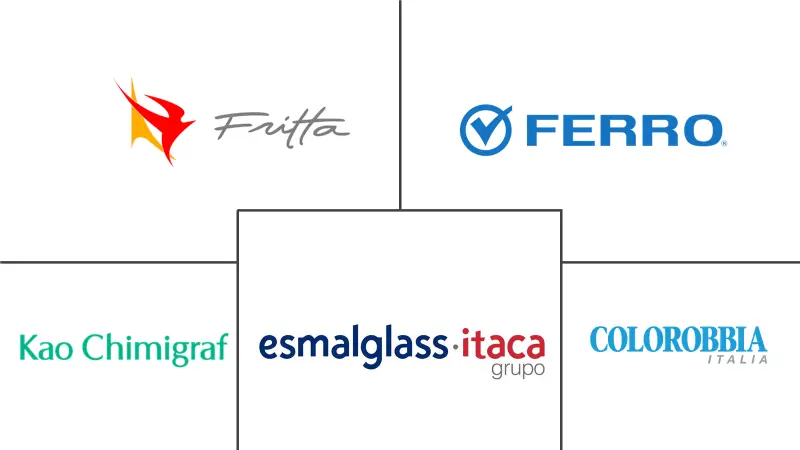Market Size of Ceramic Inks Industry

| Study Period | 2019 - 2029 |
| Market Size (2024) | USD 2.64 Billion |
| Market Size (2029) | USD 3.68 Billion |
| CAGR (2024 - 2029) | 6.89 % |
| Fastest Growing Market | Asia Pacific |
| Largest Market | Asia Pacific |
Major Players
*Disclaimer: Major Players sorted in no particular order |
Ceramic Inks Market Analysis
The Ceramic Inks Market size is estimated at USD 2.64 billion in 2024, and is expected to reach USD 3.68 billion by 2029, growing at a CAGR of 6.89% during the forecast period (2024-2029).
The COVID-19 pandemic negatively impacted the market. It was because of the shutdown of the manufacturing facilities and plants due to the lockdown and restrictions. Supply chain and transportation disruptions further created hindrances for the market. However, the industry witnessed a recovery in 2021, thus rebounding the demand for the market studied.
- Over the short term, increasing demand for decorative glass and tiles are some factors driving the studied market's growth.
- Conversely, high-cost involvement in shifting from analog to digital technology will likely hinder the market's growth.
- However, technological advancements in digital printing are projected to act as an opportunity for the market shortly.
- Asia-Pacific is expected to dominate the global ceramic ink market during the forecast period.
Ceramic Inks Industry Segmentation
Ceramic inks are essential carriers for fine-particle metallic oxide pigments (not raw colorants, but preferred stain powders) utilized in automatic application procedures. Depending on the application technique, these materials can be thick and flow like printing ink. Glass printing, ceramic tile printing, and food container printing all require ceramic inks. The market is segmented based on product type, printing technology, application, and geography. The market is segmented by product type into functional and decorative inks. By printing technology, the market is segmented into digital and analog printing. The market is segmented by application into ceramic tiles, glass printing, food container printing, and other applications. The report offers market size and forecasts for 15 countries across major regions. For each segment, market sizing and forecasts are based on revenue (USD) for all the above segments.
| Product Type | |
| Functional Inks | |
| Decorative Inks |
| Printing Technology | |
| Digital Printing | |
| Analog Printing |
| Application | ||||
| ||||
| Glass Printing | ||||
| Food Container Printing | ||||
| Other Applications |
| Geography | |||||||
| |||||||
| |||||||
| |||||||
| |||||||
|
Ceramic Inks Market Size Summary
The ceramic inks market is poised for significant growth over the forecast period, driven by increasing demand for decorative glass and tiles. The market experienced a setback due to the COVID-19 pandemic, which caused disruptions in manufacturing and supply chains. However, it rebounded in 2021, with technological advancements in digital printing presenting new opportunities. The shift from analog to digital technology, while beneficial, poses challenges due to high costs. The Asia-Pacific region is expected to dominate the market, with countries like China and India leading the charge due to their robust construction sectors and infrastructure investments. The demand for ceramic tiles, known for their durability and aesthetic appeal, is particularly strong, fueled by rising residential construction and changing consumer preferences in developing economies.
The market's growth is further supported by the expanding construction industry, with significant investments in both residential and commercial projects. In India, government initiatives and budget allocations are boosting the residential sector, while China's massive construction output continues to drive demand. Additionally, the food printing sector in India presents a growing market for ceramic inks, particularly in food packaging. The fragmented nature of the market sees major players like Ferro Corporation and Colorobbia Italia SpA actively expanding their capabilities to meet rising demand. Recent developments, such as Tecglass's expansion of digital printing facilities and Colorobbia's launch of new digital inks, underscore the industry's commitment to innovation and capacity enhancement.
Ceramic Inks Market Size - Table of Contents
-
1. MARKET DYNAMICS
-
1.1 Market Drivers
-
1.1.1 Increasing Demand for Decorative Glass and Tiles
-
1.1.2 Rapid Growth in the Construction Sector
-
-
1.2 Market Restraints
-
1.2.1 High-cost Involvement in Shifting of Analog Technology to Digital Technology
-
1.2.2 Other Restraints
-
-
1.3 Industry Value Chain Analysis
-
1.4 Porter's Five Forces Analysis
-
1.4.1 Bargaining Power of Suppliers
-
1.4.2 Bargaining Power of Buyers
-
1.4.3 Threat of New Entrants
-
1.4.4 Threat of Substitute Products and Services
-
1.4.5 Degree of Competition
-
-
-
2. MARKET SEGMENTATION (Market Size in Value)
-
2.1 Product Type
-
2.1.1 Functional Inks
-
2.1.2 Decorative Inks
-
-
2.2 Printing Technology
-
2.2.1 Digital Printing
-
2.2.2 Analog Printing
-
-
2.3 Application
-
2.3.1 Ceramic Tiles
-
2.3.1.1 Residential
-
2.3.1.2 Non-residential
-
-
2.3.2 Glass Printing
-
2.3.3 Food Container Printing
-
2.3.4 Other Applications
-
-
2.4 Geography
-
2.4.1 Asia-Pacific
-
2.4.1.1 China
-
2.4.1.2 India
-
2.4.1.3 Japan
-
2.4.1.4 South Korea
-
2.4.1.5 Rest of Asia-Pacific
-
-
2.4.2 North America
-
2.4.2.1 United States
-
2.4.2.2 Canada
-
2.4.2.3 Mexico
-
-
2.4.3 Europe
-
2.4.3.1 Germany
-
2.4.3.2 United Kingdom
-
2.4.3.3 France
-
2.4.3.4 Italy
-
2.4.3.5 Rest of Europe
-
-
2.4.4 South America
-
2.4.4.1 Brazil
-
2.4.4.2 Argentina
-
2.4.4.3 Rest of South America
-
-
2.4.5 Middle East and Africa
-
2.4.5.1 Saudi Arabia
-
2.4.5.2 South Africa
-
2.4.5.3 Rest of Middle East and Africa
-
-
-
Ceramic Inks Market Size FAQs
How big is the Ceramic Inks Market?
The Ceramic Inks Market size is expected to reach USD 2.64 billion in 2024 and grow at a CAGR of 6.89% to reach USD 3.68 billion by 2029.
What is the current Ceramic Inks Market size?
In 2024, the Ceramic Inks Market size is expected to reach USD 2.64 billion.

